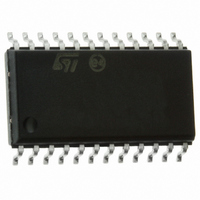ST72F63BE2M1 STMicroelectronics, ST72F63BE2M1 Datasheet - Page 110

ST72F63BE2M1
Manufacturer Part Number
ST72F63BE2M1
Description
MCU 8BIT LS USB 8KB FLASH 24SOIC
Manufacturer
STMicroelectronics
Series
ST7r
Datasheet
1.ST72F63BD6U1TR.pdf
(186 pages)
Specifications of ST72F63BE2M1
Core Processor
ST7
Core Size
8-Bit
Speed
8MHz
Connectivity
I²C, SCI, USB
Peripherals
DMA, LVD, POR, PWM, WDT
Number Of I /o
14
Program Memory Size
8KB (8K x 8)
Program Memory Type
FLASH
Ram Size
1K x 8
Voltage - Supply (vcc/vdd)
4 V ~ 5.5 V
Oscillator Type
Internal
Operating Temperature
0°C ~ 70°C
Package / Case
24-SOIC (7.5mm Width)
Data Converters
A/D 12x10b
Processor Series
ST72F6x
Core
ST7
Data Bus Width
8 bit
Data Ram Size
384 B
Interface Type
I2C, SCI
Maximum Clock Frequency
8 MHz
Number Of Programmable I/os
14
Number Of Timers
1
Maximum Operating Temperature
+ 70 C
Mounting Style
SMD/SMT
Development Tools By Supplier
ST7MDTU3-EPB/US, ST7MDTULS-EVAL, ST72F63B-SK/RAIS, ST7MDTU3-EMU3, STX-RLINK
Minimum Operating Temperature
0 C
For Use With
497-8209 - BOARD EVAL USB STUSB02E/ST72F63B497-8208 - BOARD EVAL USB STUSB03E/ST72F63B497-5521 - EVAL BOARD LOW SPEED USB497-5046 - KIT TOOL FOR ST7/UPSD/STR7 MCU
Lead Free Status / RoHS Status
Lead free / RoHS Compliant
Eeprom Size
-
Lead Free Status / Rohs Status
Details
Other names
497-5624-5
Available stocks
Company
Part Number
Manufacturer
Quantity
Price
On-chip peripherals
110/186
Mode selection
The interface can operate in the four following modes:
●
●
By default, it operates in slave mode.
The interface automatically switches from slave to master after it generates a START
condition and from master to slave in case of arbitration loss or a STOP generation, allowing
then Multi-Master capability.
Communication flow
In Master mode, it initiates a data transfer and generates the clock signal. A serial data
transfer always begins with a start condition and ends with a stop condition. Both start and
stop conditions are generated in master mode by software.
In Slave mode, the interface is capable of recognizing its own address (7-bit), and the
General Call address. The General Call address detection may be enabled or disabled by
software.
Data and addresses are transferred as 8-bit bytes, MSB first. The first byte following the
start condition is the address byte; it is always transmitted in Master mode.
A 9th clock pulse follows the 8 clock cycles of a byte transfer, during which the receiver must
send an acknowledge bit to the transmitter. Refer to
Figure 46. I²C bus protocol
Acknowledge may be enabled and disabled by software.
The I²C interface address and/or general call address can be selected by software.
The speed of the I²C interface may be selected between Standard (up to 100 kHz) and Fast
I²C (up to 400 kHz).
SDA/SCL line control
Transmitter mode: the interface holds the clock line low before transmission to wait for the
microcontroller to write the byte in the Data register.
Receiver mode: the interface holds the clock line low after reception to wait for the
microcontroller to read the byte in the Data register.
The SCL frequency (F
the I²C bus mode.
When the I²C cell is enabled, the SDA and SCL ports must be configured as floating inputs.
In this case, the value of the external pull-up resistor used depends on the application.
Slave transmitter/receiver
Master transmitter/receiver
SCL
SDA
CONDITION
START
SCL
MSB
) is controlled by a programmable clock divider which depends on
1
Doc ID 7516 Rev 8
2
8
Figure
ACK
9
46.
CONDITION
STOP
VR02119B
ST7263Bxx














